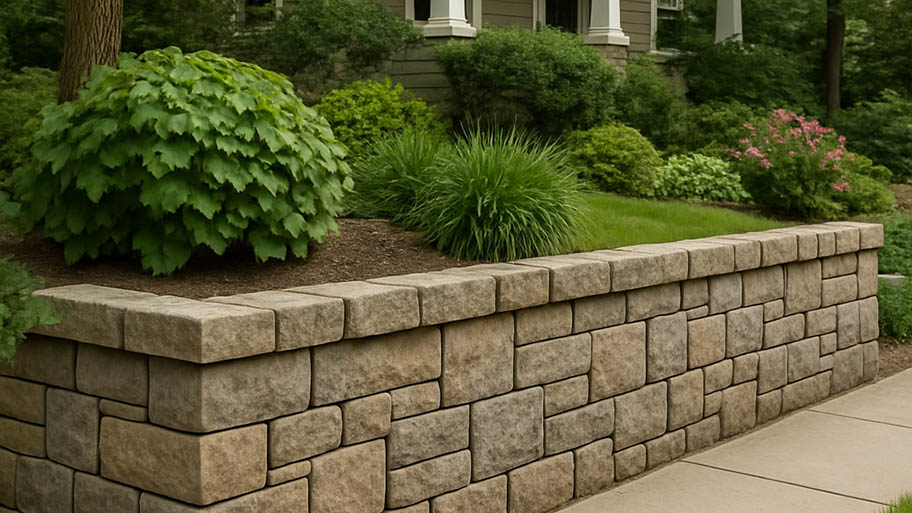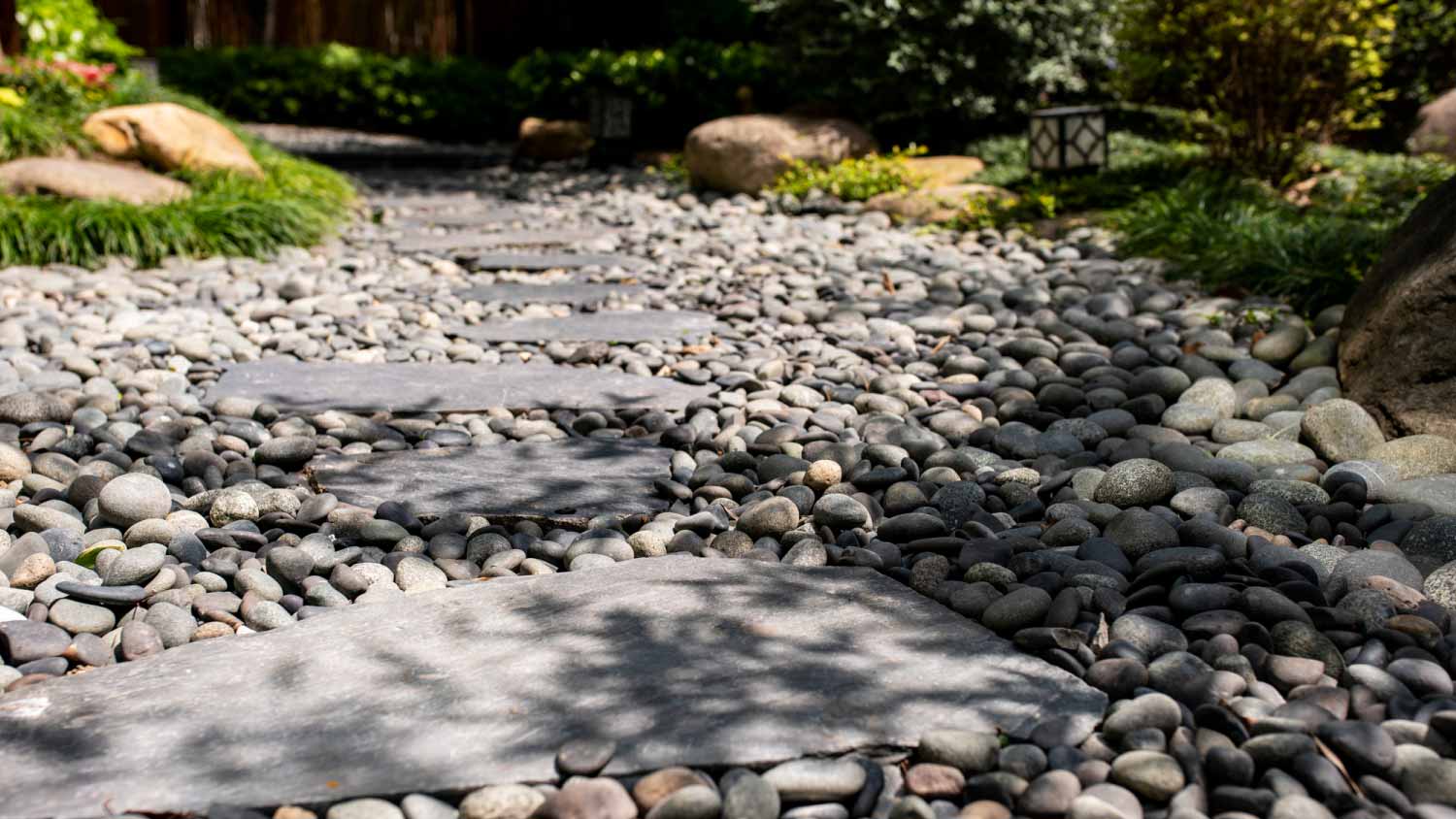
Kick erosion to the curb with an eye-catching retaining wall. Retaining wall costs vary based on the material, but this guide will help you budget.


The size of your landscaping project determines how much river rock you need.
For a 100-square-foot project, you need 0.7 to 1.3 cubic yards of river rock.
A river rock installation of that size would cost somewhere between $200 and $500.
How much river rock do I need? Let’s dive in. Whether you’re using river rock for a pathway, garden bed, or water feature, buying the right amount is key to the success of your landscaping project. The amount you need depends on the size of your space. Here’s how to calculate the right amount of river rock for your project.
The amount of river rock you need will depend largely on the size of your landscaping project. In the table below, you can see approximately how much river rock to buy for different project sizes.
River rock installations typically range from 2 to 4 inches in depth but can vary significantly in length and width. To find the square footage of your project, simply multiply the length and width of the space.
Heads up: Landscaping and garden supply companies sell river rock in a few different ways, including by volume (in cubic yards) or weight (in tons). For the purpose of this river rock calculator, we’ll use cubic yards.
| Project Size | Cubic Yards of River Rock Required | Average Cost |
|---|---|---|
| 10 sq. ft. | 0.06–0.12 | $150–$300 |
| 25 sq. ft. | 0.15–0.3 | $150–$300 |
| 50 sq. ft. | 0.3–0.6 | $150–$300 |
| 100 sq. ft. | 0.7–1.3 | $200–$500 |
| 500 sq. ft. | 3–6 | $400–$1,800 |
To figure out how much river rock you should order, you’ll need to know the length, width, and depth of your project area. When you multiply these dimensions, you’ll get the size of your project in cubic feet. Then, to convert it to cubic yards, you’ll divide by 27.
Here’s how the formula works:
Total River Rock Required (in cubic yards) = (Length (in feet) x Width (in feet) x Depth (in feet)) / 27
For example, let’s say you’re planning to install river rock in a space that’s 5 feet wide, 10 feet long, and 3 inches deep. This means you’ll need 12.5 cubic feet—or 0.46 cubic yards—of rocks.
Before you can calculate how much river rock to order, you’ll need to take a few measurements and do some basic math. Here are the steps to follow, depending on the shape of your space:
If you’re filling in a rectangular area (like a driveway or pathway) with river rock, here’s how to calculate how much rock you need:
Measure the length and width of the space.
Choose a depth for your river rock installation (typically, this should be between 2 and 4 inches).
Convert all three figures into feet.
Multiply them together to get the volume of river rock in cubic feet.
Divide the result by 27 to convert from cubic feet into cubic yards and get the total amount of river rock you need.
To find the square footage of a circular area, follow these steps:
Measure the diameter of the circle and divide it in half to find the radius.
Square the radius by multiplying it by itself.
Multiply the squared radius by pi (π = 3.14159265) to get the square footage of the area.
Multiply the area’s square footage by the depth of your river rock (in feet) to get the volume of river rock in cubic feet.
Divide the result by 27 to convert from cubic feet into cubic yards and get the total amount of river rock you need.
For curved areas (for example, around a pond or along a garden bed), it’s easier to estimate how much river rock you should order rather than trying to get an exact number. Here’s how to do that:
Measure the longest length of the space.
Estimate the area’s average width.
Multiply the length, width, and depth of your river rock (all in feet) to get the volume in cubic feet.
Divide the result by 27 to convert from cubic feet into cubic yards and get the total amount of river rock you need.

Installing river rock is a physically demanding job, and arranging them in an aesthetically pleasing way is often harder than it looks. Instead of attempting this type of project yourself, it’s better to work with a local landscaper who can plan and manage the installation of river rock at your home.
If you’ve never hired a landscape designer before, here are a few tips to keep in mind:
Know what services you want and have a budget in mind before reaching out.
Interview multiple candidates.
Before hiring a landscaping contractor, check their qualifications, references, and online reviews.
Get all estimates and the final contract in writing.
From getting an estimate to ordering flooring to installation, Randolph and Mortimer was outstanding. This was a large installation in a commercial building but they worked with us to install the flooring quickly and around our scheduled open hours. The flooring installers were efficient and...
I know David Vaughn ( the owner ) personally and knew that he would be very thorough in his inspection of a house I was interested in purchasing. He was exactly that and I will hire him for the next house I need an Inspection for.. Very professional and on time.
From average costs to expert advice, get all the answers you need to get your job done.

Kick erosion to the curb with an eye-catching retaining wall. Retaining wall costs vary based on the material, but this guide will help you budget.

Porcelain pavers are a high-end option for your home’s hardscaping that can completely transform your outdoor space. Here’s how much porcelain pavers cost.

Need to know how much decomposed granite costs? Learn about the factors that affect decomposed granite's price and how much you need for your project.

Grab a shovel, and maybe a few water bottles to stay hydrated, then learn how to install interlocking pavers DIY in this step-by-step guide.

If your yard is looking drab, installing interlocking pavers can be a smart way to increase your home’s curb appeal. Here are some common questions you’ll discuss with a pro.

Determining how much concrete you need for stairs can involve some tricky math. Our concrete stair calculator simplifies the process. Here's how to measure.